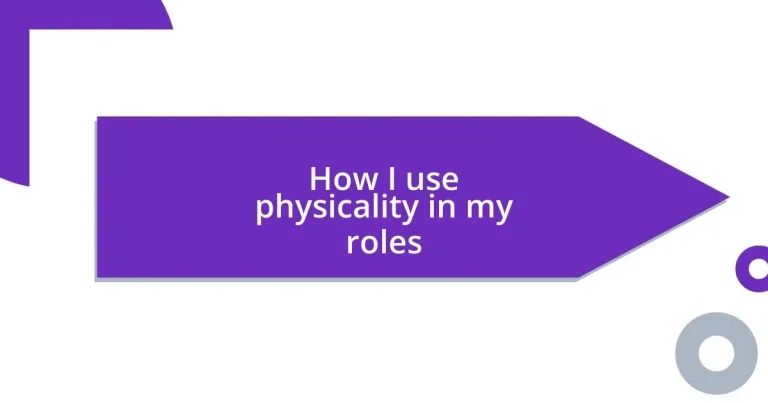Key takeaways:
- Physicality and body language are essential in acting, significantly enhancing emotional expression and character depth.
- Techniques like grounding, mirroring, and spatial awareness help actors connect emotionally with their characters and the audience.
- Subtle movements can convey profound emotions, demonstrating that even slight physical adjustments can alter scene dynamics and audience perception.
- Practicing physical exercises and observing peers fosters a deeper understanding of how physicality influences character development and narrative impact.
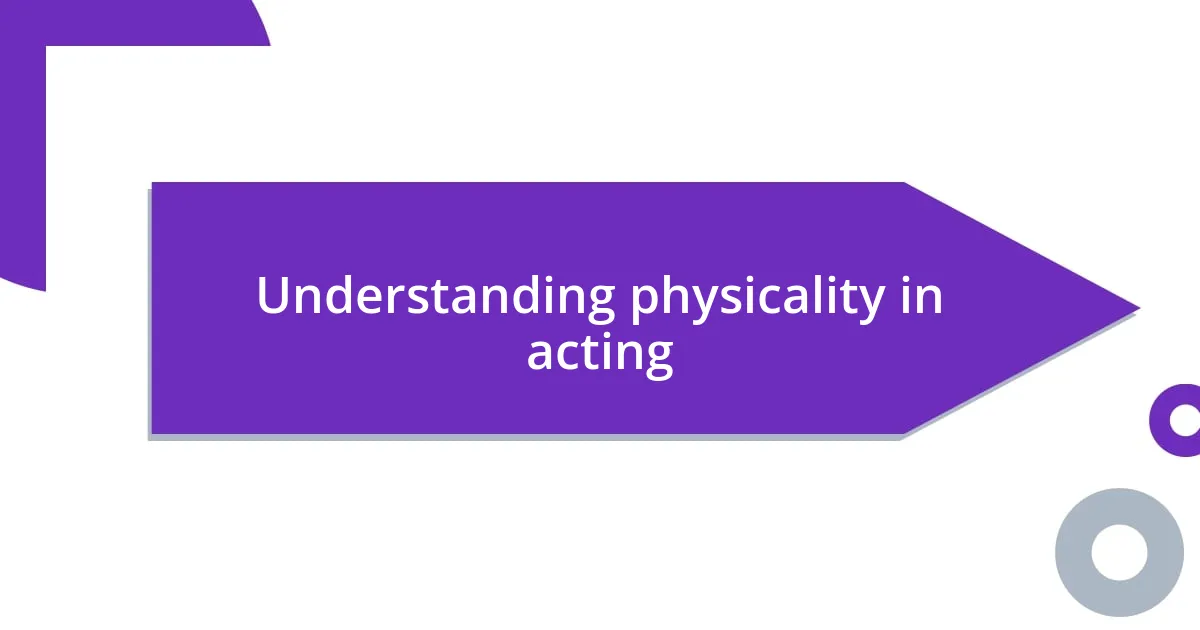
Understanding physicality in acting
Physicality in acting is about how our bodies communicate emotions and intentions, often speaking louder than words. I remember the time I played a character who was physically restrained. I had to convey desperation not just through my lines but with every muscle tensed, every shift in weight. It really made me realize how much storytelling can happen without uttering a single line.
Have you ever noticed how a simple gesture can dramatically change the essence of a scene? When I work on a character, I pay close attention to their posture, how they walk, and even their breathing. For instance, when I portrayed a confident leader, I stood tall with my chest out, and my movements were deliberate. This kind of awareness transforms how we are perceived on stage or screen, showing that physicality is a crucial part of character development.
In my experience, exploring a character’s physicality often leads to unexpected emotional revelations. There was a moment during a rehearsal when I experimented with slumped shoulders for a character who was feeling defeated. The instant I adopted that physical state, it was like a light bulb went off—I felt the weight of their sadness, and it helped me connect more deeply with the role. Isn’t it fascinating how embodying these physical traits can unlock layers of emotion within us?
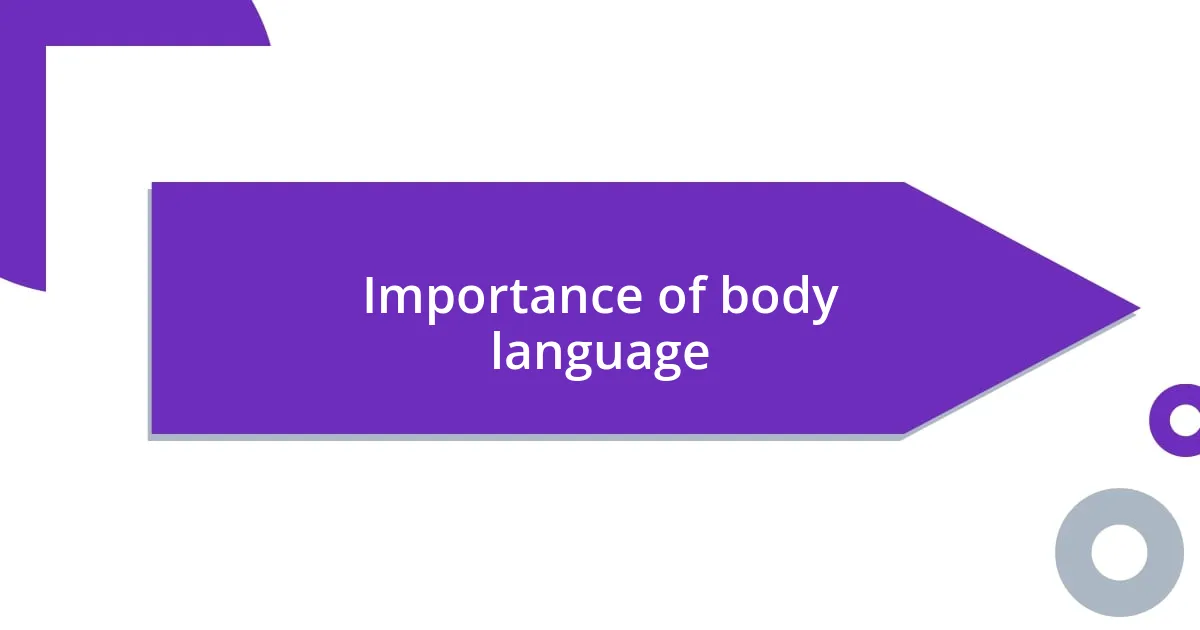
Importance of body language
Body language plays a pivotal role in how we, as actors, convey our characters’ emotions and intentions. I recall rehearsing a scene where I had to portray a character filled with anxiety. Just by fidgeting or avoiding eye contact, I found I could communicate their unease without uttering a single word. This experience reaffirmed my belief that our physical presence can express a wealth of emotions, giving depth to our performances that dialogue alone often cannot provide.
The nuances of body language can transform a performance significantly. For instance, in a recent role, I had to embody a heartbroken lover. By allowing my shoulders to droop and my head to lower, I wasn’t just acting sad; I was physically manifesting their heartbreak. This approach connected me to the audience on a deeper level, as they could empathize with the character simply through the visual cues of my body. Isn’t it intriguing how slight adjustments in physicality can shift the entire energy of a scene?
Understanding body language is essential, not just for acting, but for relatable human interactions. I often observe how a confident posture can change the atmosphere in a room. When I walk into an audition confidently, with open gestures, I feel the energy shift positively. This awareness of physicality doesn’t just serve our characters; it enhances our interactions in everyday life.
| Aspect | Impact |
|---|---|
| Posture | Conveys confidence or vulnerability |
| Gestures | Enhances emotional expression |
| Facial Expressions | Reveals internal states instantly |
| Movement | Indicates character’s energy level and mood |
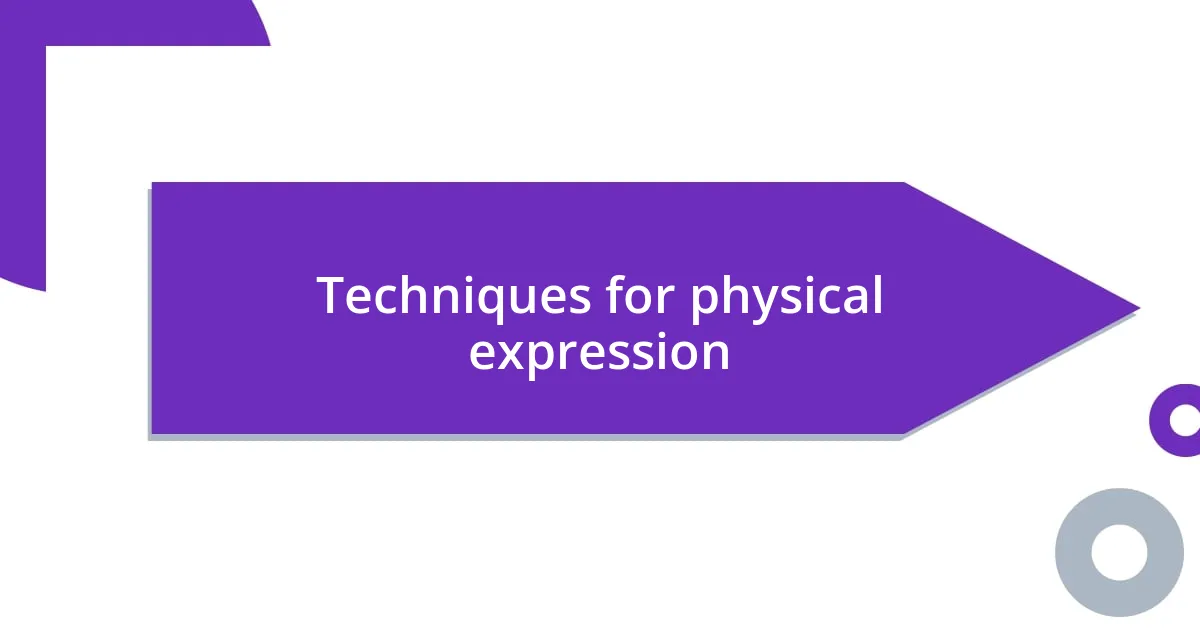
Techniques for physical expression
In my journey as an actor, I’ve discovered several techniques of physical expression that profoundly enhance my performances. One technique I particularly value is mirroring. When working with a scene partner, I often subtly mimic their movements and energy—this helps establish a deeper connection and enhances the emotional resonance of our interaction. I remember a moment in a scene where I mirrored my partner’s anxious gestures; I could feel our characters syncing, amplifying the tension and vulnerability between them.
Here’s a quick list of techniques I use for physical expression:
- Grounding: Focusing on my feet connecting with the floor helps me stay present and portray stability—or the lack thereof.
- Isolation: Moving only specific body parts can convey distinct emotions; for instance, isolating my arms when expressing frustration can bring a unique intensity.
- Voice and Breath: Adjusting my breathing pattern not only affects my speech but also reflects my character’s emotional state, like quick, shallow breaths to signify panic.
- Spatial Awareness: Understanding how my position relative to other characters shapes the crowd’s perception of relationships adds layers to scenes.
These techniques allow me to connect on a visceral level, drawing the audience into the story through physicality. Often, it’s the moments where I embrace vulnerability by allowing my body to express what the words can’t that resonate the most with viewers. For instance, when I performed in a role that required me to show utter despair, crouching low on the ground while burying my head in my hands felt more authentic than any dialogue could express. Engaging my body in this way creates a dialogue with the audience that transcends spoken words.
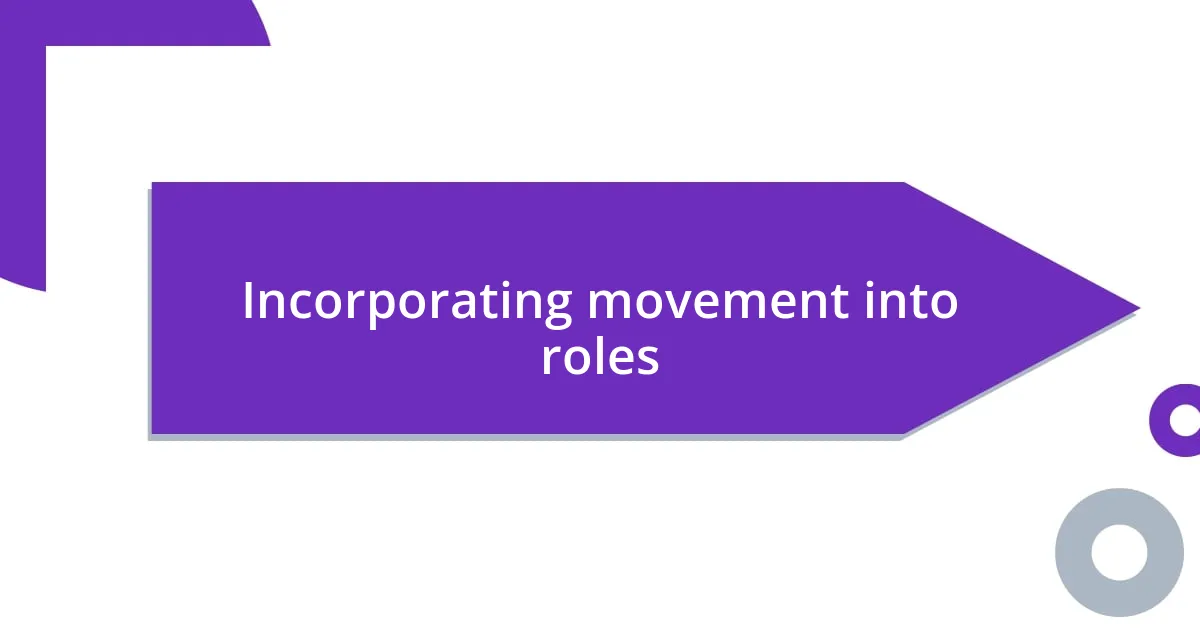
Incorporating movement into roles
Incorporating movement into my roles opens up a whole new dimension of storytelling. I often find that when I incorporate intentional movements, like pacing or leaning into a conversation, it instantly shifts the energy of the scene. For instance, during a recent performance where my character was on edge, I chose to move erratically around the stage. This not only highlighted my character’s mental state but also made the audience feel that nervous energy, almost as if they were experiencing it alongside me.
I remember a rehearsal where I was cast as a mentor figure, embodying strength and wisdom. Instead of standing still with my hands crossed, I opted to walk slowly around my scene partner, using my movement to reinforce my character’s approachability. It felt like I was literally surrounding them with support. This blend of movement and physical presence really illustrates how our actions can deepen the audience’s understanding of the dynamics at play. Isn’t it fascinating how just the way you move can transform an interaction?
Another incredible realization I’ve had is that movement doesn’t have to be grand to be impactful. I often use subtle shifts—like a slight turn of the head or an almost imperceptible step back—to demonstrate internal conflict or hesitation. During a poignant moment in a play, I took a small step away from another character when delivering heartbreaking news. That tiny action spoke volumes, conveying the emotional weight of the moment much more than any words could. It’s these nuanced movements that can truly resonate, pulling viewers into the emotional core of a scene. How do you think a simple gesture can change the meaning of an entire exchange?
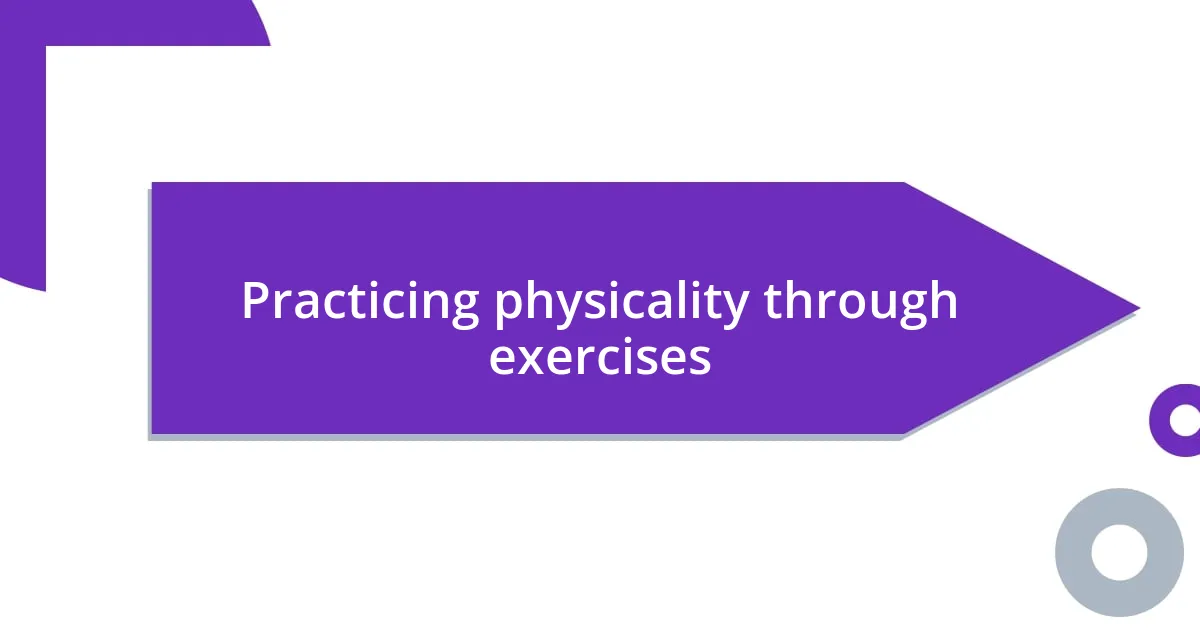
Practicing physicality through exercises
Practicing physicality through exercises has been a crucial part of my development as an actor. One exercise I find particularly effective is the “body language mirror” technique, where I partner with a fellow actor to mimic each other’s movements and expressions. It’s fascinating how this simple act can reveal hidden emotions and dynamics. I remember a rehearsal where I mirrored my partner’s anxious fidgeting. This exchange deepened our connection, and both of us came away feeling more in tune with our roles.
Another valuable exercise is the “emotion walk,” where I choose a specific feeling and walk across the stage while embodying that emotion through my whole body. I recall once walking with sheer joy, letting my arms swing freely and my steps bounce lightly. The experience was liberating, and it translated into my performance in that scene, making the onset of laughter seem more organic. Can you imagine how much a character’s walk can reflect their inner world?
I also love practicing grounding techniques, focusing on my feet and their connection to the ground. This might sound simple, but it really enhances my awareness during performances. During one poignant workshop, I deliberately pressed my feet into the floor while delivering a heartfelt monologue. The physical sensation of being grounded allowed the emotional weight of the words to come through so much more powerfully. I guess I’ve learned that by marrying my physicality with my emotional state, I can transform the way the audience experiences a scene. Have you ever thought about how grounding yourself might shift your own presence?
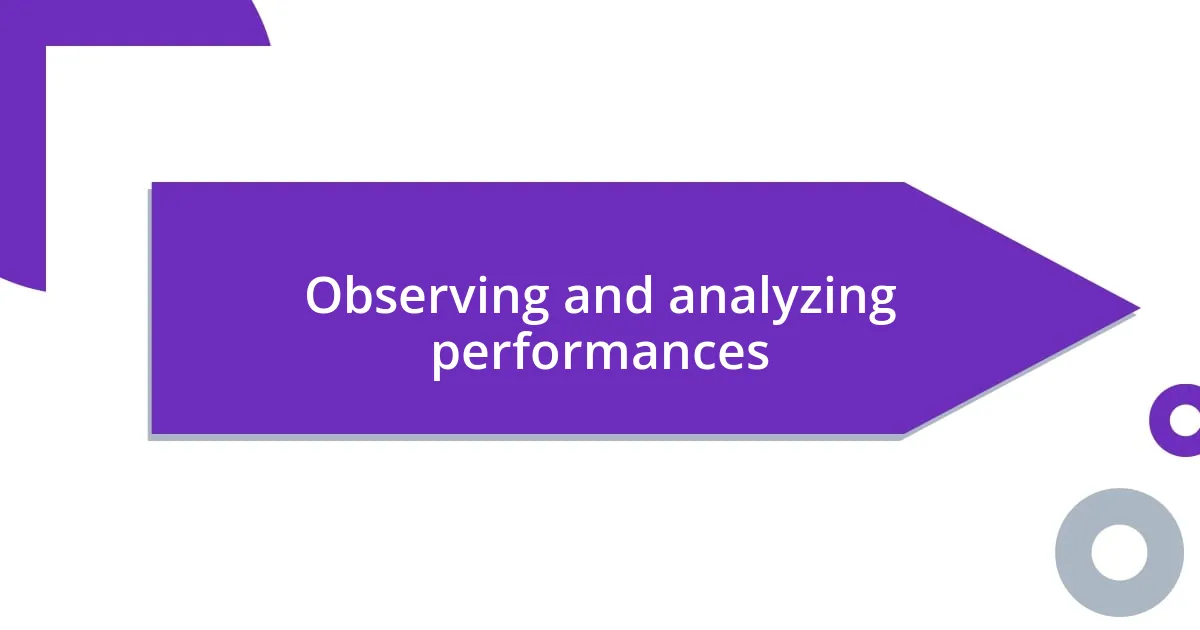
Observing and analyzing performances
One of the most enlightening parts of observing performances is noticing how physicality can completely alter a scene’s impact. I once watched a fellow actor deliver a monologue while hunched over, barely making eye contact. The vulnerability in their posture conveyed a deep sense of despair, making that moment all the more heart-wrenching. In contrast, when I performed a similar scene standing tall with an open stance, the energy shifted dramatically, reflecting strength despite the emotional turmoil. It’s fascinating to see how different physical choices can evoke entirely different feelings in the audience—have you ever thought about what your own stance communicates?
Analyzing performances also gives me insight into how subtle gestures can deepen a narrative. I remember attending a workshop where one actor used their hands to articulate thoughts even during silence. It struck me that even a slight hand movement could bridge unspoken emotions, drawing in the audience. I never realized how a mere flicker of the fingers could express longing or frustration until I started paying closer attention to those details. Isn’t it incredible how much meaning can be packed into such small actions?
Additionally, I’ve found that observing how my peers embody their characters provides valuable lessons. For example, a classmate of mine played a character who was exuberant and energetic. Their physicality—bounding around the stage, arms flailing with excitement—created an infectious energy that made the audience laugh and smile along. It made me reflect: how can my own movements create that kind of joy? This type of reflection can significantly affect my own performances, as it challenges me to infuse more dynamism into my portrayals. What physical choices are you inspired to explore after watching someone else?
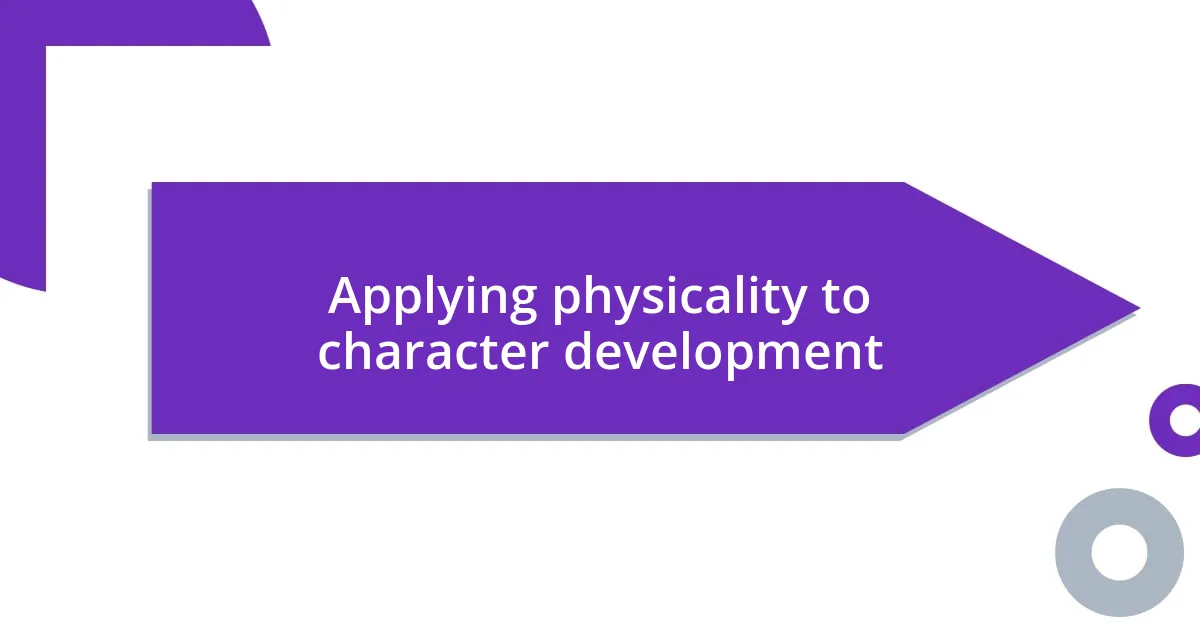
Applying physicality to character development
When I focus on physicality, I often discover layers to my characters that I might overlook otherwise. Take, for example, a role I played where the character was deeply troubled. I started experimenting with the weight of my shoulders—allowing them to droop as if the burden of sadness was physically dragging me down. The result was astonishing; that small adjustment not only altered my own mindset during performances but also made the audience feel the heaviness of the character’s despair. Have you ever considered how something as simple as posture can reveal so much about a character’s emotional state?
I also enjoy exploring how the rhythm of movement can define a character’s personality. In one instance, I portrayed a whimsical, carefree character who loved running through the grass as if it were a dance floor. I found myself incorporating playful skips and twirls into my performance. This approach brought an entirely new energy to my interactions with other characters, making the playful banter feel even more alive. Isn’t it enlightening to realize how a character’s physical energy can add depth to their relationships?
One of the most powerful moments for me came when I experimented with contrasting physicalities in a dual role. I played a stern authority figure and a lighthearted romantic interest. Shifting between rigid, deliberate movements for the authority role to flowing, spontaneous gestures for the romantic one was incredibly liberating. It transformed how I engaged with the cues and reactions from my scene partners, amplifying the emotional stakes in both relationships. Have you thought about how changing your physical presence could transform the dynamics of the characters you play?












